
 Decade defining yachts
Decade defining yachts
Rupert Holmes completes his series on popular classics with yachts built since 2010: A common complaint about the latest generation of new yachts is that they just represent ‘more big, white plastic.’ While it’s true some simply continue existing design trends without offering new ideas, there are also a number of genuinely innovative small and medium sized boats that are moving the game forward…”
 Sonata around Scotland
Sonata around Scotland
One couple’s summer odyssey circumnavigation in a 22-footer: Douglas and I were 14 when we first met. We raced each other in Toppers for a few years, but then went our separate ways. Fate threw us back together when we found ourselves teaching for the Aberdeenshire Sailing Trust over 10 years later. Our first dates were spent travelling down to the Clyde to race and cruise Doug’s little 23ft Sonata, Vamonos. It was during these trips that we started dreaming of further horizons, and discussed the possibility of circumnavigating Scotland…”
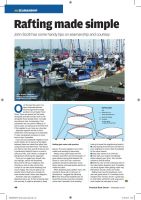 Rafting made easy
Rafting made easy
The essential etiquette and technique for lying alongside another boat: “Over the past few years I’ve spent extended periods moored against the single pontoon at Lymington Town Quay. There are spaces for five boats alongside and later arrivals have to raft alongside those already there, normally according to size. Increasingly, I find, yachtsmen are not used to rafting or, in some cases, are doing so for the first time. If that applies to you, here are a few tips…”
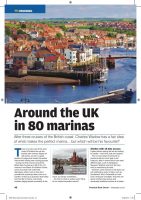 Perfect port hopping
Perfect port hopping
Around the UK in 80 marinas – one reader describes his favourite stops from three separate UK circumnavigations: “Those of us who sail off the west coast of Scotland are not too familiar with marinas. Mostly we still anchor, so are in a good position to judge what makes the perfect marina when visiting new cruising grounds. During my three cruises around the British Isles I’ve tied up in 80 of the 178 marinas in the Reeds 2018 Marina Guide; some very swish with uniformed attendants, others more or less do-it-yourself…”
 Mighty locks of Panama
Mighty locks of Panama
Transiting the Panama Canal is not for the faint-hearted, as Huw Williams reports: “The Panama Canal is one of the world’s great engineering projects. Spanning the Isthmus of Panama, it connects the Atlantic and Pacific oceans and is 77km long. Construction began in 1881 by the French, who later abandoned the project due to engineering difficulties and disease among the workers. The Americans took over in 1904 and completed the project a few weeks before the outbreak of World War I. Since then hundreds of thousands of ships have passed along its length… and now it’s my turn…”
 French waters rescue
French waters rescue
Gilbert Park feels the pressure as engine failure leaves him stranded in the path of an oncoming storm: “It was a lovely Saturday morning in Cannes and it seemed just the right time to spend a night swinging on the hook by one of the islands five or six miles away...”
 Across the Thames estuary
Across the Thames estuary
A look at the passage plan for the 80-mile sail from Walton-on-the-Naze to Dover: “I have lived near the East Coast for many years but was born and bred in the south, which is where I learned to sail. For the first few years of living in the east I explored the many rivers and creeks, but in all that time never really fell in love with the North Sea. Consequently, for the last 20 years I have always tended to venture south each summer. This has meant many crossings of the Thames estuary...”
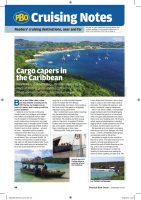 Caribbean cargo tales
Caribbean cargo tales
Sailing solo on a shoestring between Venezuela and Antigua: “Back in the 1980s, after a slow (35-day) Atlantic crossing on my 22ft Hurley, my budget was in need of a boost, and I came up with the perfect solution!”
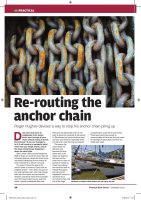 Chain locker redesign
Chain locker redesign
Roger Hughes finds room for all of his anchor chain and devises a simple feed pipe: “Does your boat have an inadequate chain locker, which won’t accept all your chain without having to knock the pile over? If you can manage to fix it, it will come as a wonderful relief every time you weigh anchor, and all the chain mysteriously disappears down the navel pipe. Here’s what I did to accommodate the 250ft of chain on my 22-ton Down East 45 schooner Britannia…”
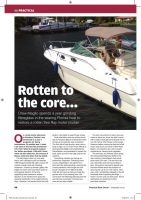 Restoring a motorboat
Restoring a motorboat
Chasing down the hidden rot inside a Sea Ray Sundancer: “On a brisk winter afternoon in Southern Florida I was sentenced to a year’s purgatory for being overzealous. So excited was I, when I set eyes on the Sea Ray Sundancer 270, that I failed to properly inspect her before purchase. Little did I know, when we test sailed her, the amount of blood, sweat and tears that lay ahead…”
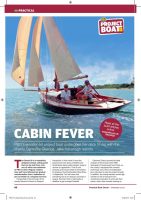 Project Boat: deck and cabin building
Project Boat: deck and cabin building
Work begins on the decking and cabin sides for the Oarsome Chance charity team: “The Secret 20 is a beautifully designed classic sailing yacht that can be built from a kit, one of which was delivered to PBO in 2016. Regular readers may well have followed her gradual transformation from a collection of pre-cut timber to a shapely hull form. Transported to the premises of the charity Oarsome Chance in Gosport, Hampshire, in last month’s issue the plywood hull was epoxy sheathed and faired before being rolled upright, ready to receive its upperworks…”
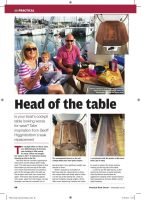 DIY new teak table
DIY new teak table
A failing, folding cockpit table is redesigned and rebuilt: “The cockpit table on Tessa Jane, our 2005 Bavaria 39 Cruiser, was looking a little worse for wear. Since we bought her early in 2017, it had been slowly moving up the to-do list.
Not only did the cosmetic appearance need work, but the design didn’t really work...”
 Needlework for sails
Needlework for sails
Ken Endean’s tips on the basic tools and techniques: “Chafe damage has always been a problem on yachts, and owners are generally advised to preserve their sails by adding protective devices to the rigging. However, we don’t want baggywrinkles on our shrouds, nor do we wish to invite corrosion by encasing stainless steel rigging in plastic tubes…”
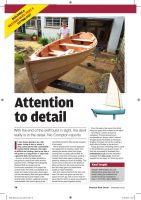 14ft skiff final details
14ft skiff final details
Fitting the timber elements to the epoxy-ply Western Skiff: “ It was always going to be a tall order: trying to turn a ‘quick ‘n’ dirty’ epoxy ply kit into a beautifully crafted family heirloom. Not quite as difficult as turning a sow’s ear into a silk purse or a bag of fish ‘n’ chips into a gourmet dish, but not far off. As soon as Jeremy Butler decided he was going to varnish the inside and the bulwarks of his 14ft Nigel Irens-designed Western Skiff, he ramped up the construction standards of his project by several levels…”



